AUDI S4 SEDAN 2013 Owners Manual
Manufacturer: AUDI, Model Year: 2013, Model line: S4 SEDAN, Model: AUDI S4 SEDAN 2013Pages: 294, PDF Size: 73.71 MB
Page 181 of 294
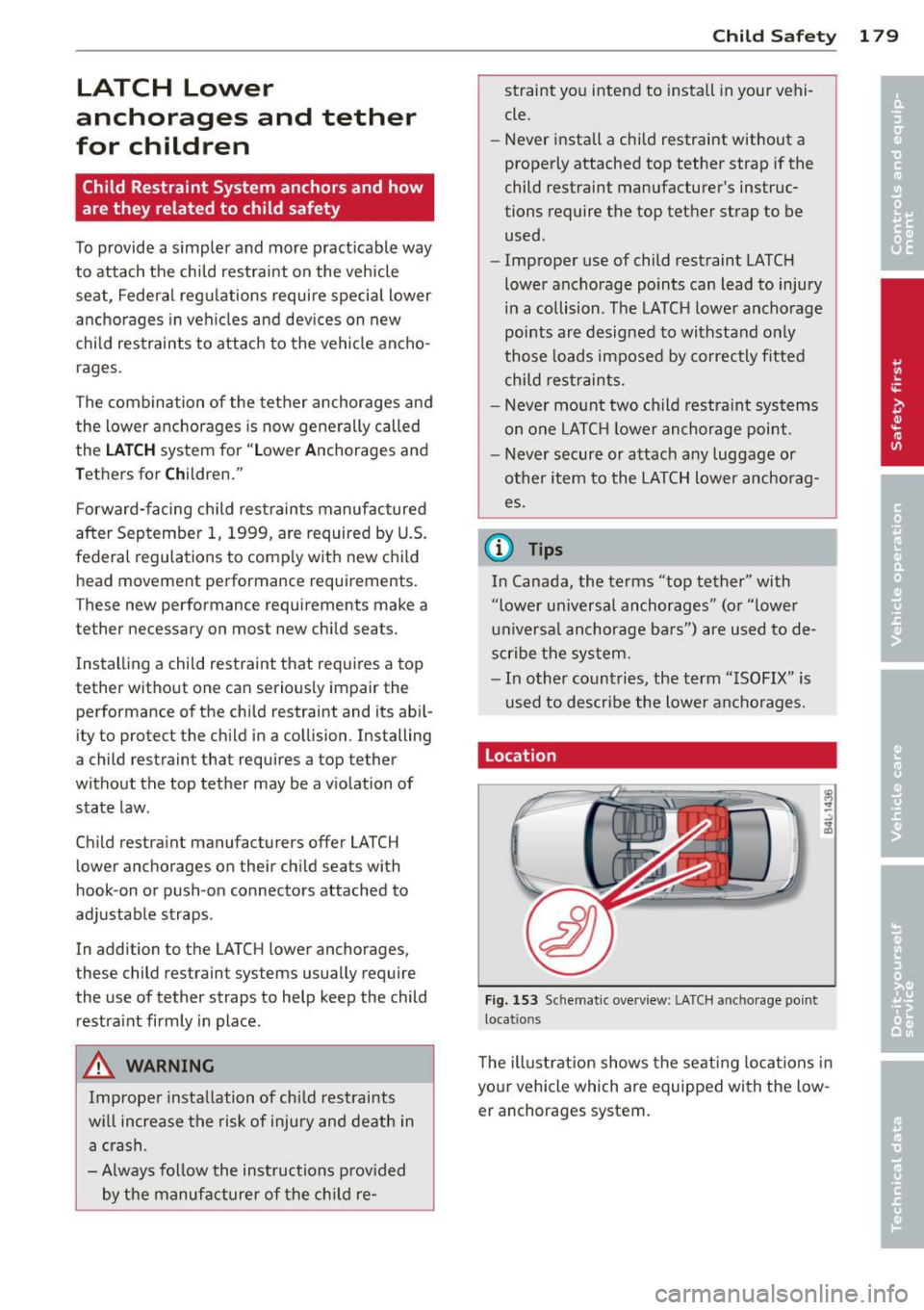
LATCH Lower
anchorages and tether
for children
Child Restraint System anchors and how
are they related to child safety
To provide a s impler and more pract icable way
to attach the child restraint on the vehicle
seat, Federal regu lations require special lower
anchorages in vehicles and dev ices on new
child restraints to attach to the vehicle ancho
rages.
The combination of the tether anchorages and
the lower anchorages is now generally called
the
LA TCH system for "Lower Anchorages and
Tethers for Children ."
F orward-facing child restraints manufactured
after September 1, 1999, are required by U.S.
federal regulations to comply with new ch ild
head movement performance requirements .
T hese new performance requirements make a
tether necessary on most new child seats.
I nstalling a chi ld restraint that requires a top
tether without one can seriously impair the
performance of the chi ld restraint and its ab il
ity to protect the child in a co llision . Installing
a child restraint that requires a top tether
without the top tether may be a v iolation of
state law.
Ch ild restraint manufacturers offer LATCH
lower anchorages on their ch ild seats with
hook -on or push-on connectors attached to
adj ustable straps.
In addition to the LATCH lower anchorages,
these child restraint systems usually require
the use of tether straps to help keep the child
restra int firmly in place .
A WARNING
Improper insta llation of chi ld restraints
w ill increase the risk of inju ry and death in
a crash.
- Always follow the instructions p rov ided
by the manufacturer of the ch ild re-
Child S afety 1 79
straint you intend to install in your vehi
cle.
- Never install a chi ld restraint without a
properly attached top tether strap if the
child restraint manufacturer's instruc
tions require the top tether strap to be
used.
- Improper use of child restraint LATC H
lower anchorage points can lead to injury
in a collision . The LATC H lowe r anchorage
points ar e designed to withstand on ly
those loads imposed by correctly fitted
child restraints.
- Never mo unt two ch ild restra int systems
on one LATC H lower anchorage point.
- Never secure or a ttach any luggage or
o ther item to the LATCH lower anchorag
es.
a) Tips
In Canada, the terms "top tether" with
"lower u niversal anchorages" (or "lower
universa l anchorage ba rs") are used to de
scribe the sys tem.
- In other countries, the t erm " ISOFIX" is
used to describe the lower a nch o rages.
Location
Fi g. 153 Sc hema tic overv iew: LA TCH ancho rage point
l ocations
T he illust rat ion shows the seati ng loca tions in
yo ur vehicle which are equipped with the low
er anchorages system.
Page 182 of 294
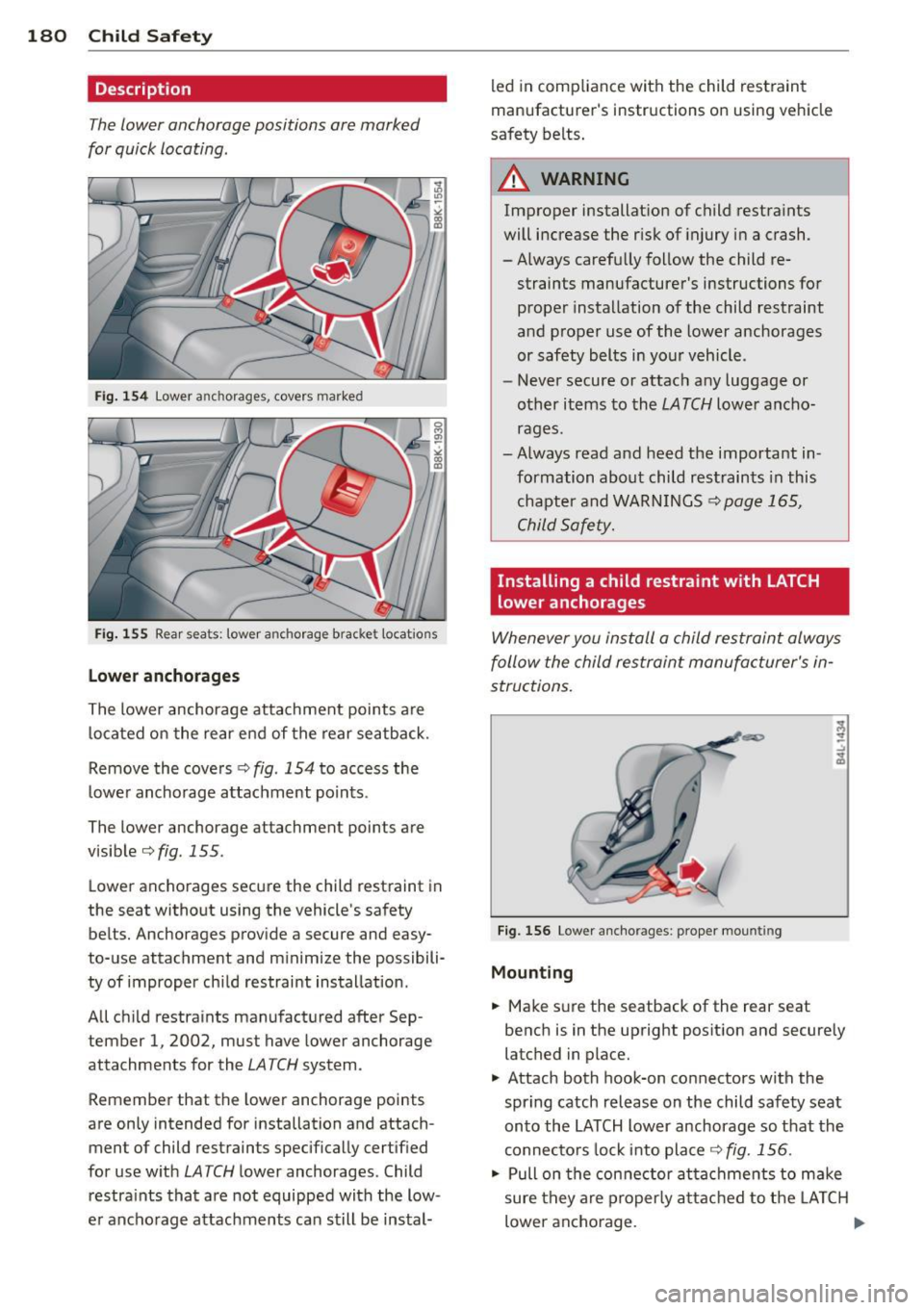
180 Child Safet y
Description
The lower anchorage positions are marked
for quick locating .
Fig. 154 Lower a nch orages, covers marke d
Fig. 155 Rear sea ts: towe r an ch orage b racke t locat io n s
Lowe r ancho rages
The lower anchorage atta chment points are
located on the rear end of the rear seatback.
Remove the covers¢
fig. 154 to access the
lower anchorage attachment points .
The lower anchorage attachment points are
visible ¢
fig. 155 .
Lower anchorages secure the child restraint in
the seat without using the vehicle 's safety
belts. Anchorages provide a secure and easy
to-use attachment and m inim ize the possibili
ty of improper child restraint installation .
All chi ld restraints manufactured after Sep
tember 1 , 2002, must have lower anchorage
attachments for the
LATCH system .
Remember that the lower anchorage points
are only intended for installation and attach ment of child restraints specifically certified
for use w ith
LATCH lower anchorages. Child
restra ints that are not equipped with the low
e r ancho rage attachments can still be instal- led in compliance with the child restraint
manufacturer's instructions on using vehicle
safety belts
.
A WARNING
-Improper installat ion of child restra ints
will increase the risk of injury in a crash .
-A lways carefu lly follow the child re -
straints manufacturer's instructions for proper installation of the child restraint
and proper use of the lower anchorages
or safety belts in your vehicle .
- Never secure or attach any luggage or
other items to the
LATCH lower ancho
rages.
- Always read and heed the important in formation about child restraints in this
chapter and WARN INGS
¢ page 165,
Child Safety.
Installing a child restraint with LATCH
lower anchorages -
Whenever you install a child restraint always
follow the child restraint manufacturer's in
structions.
F ig. 156 Lower a ncho rages : proper mount ing
Mounting
.. Make s ure the seatback of the rear seat
bench is in the upright posit ion and securely
latched in place.
.,. Attach both hook-on connectors with the
spring catch release on the child safety seat
onto the LATCH lower anchorage so that the
connecto rs lock i nto pla ce ¢
fig. 156.
.. Pull on the con nector attachments to make
sure they are properly a ttached to the LA T CH
lower ancho rage . ..,.
Page 183 of 294
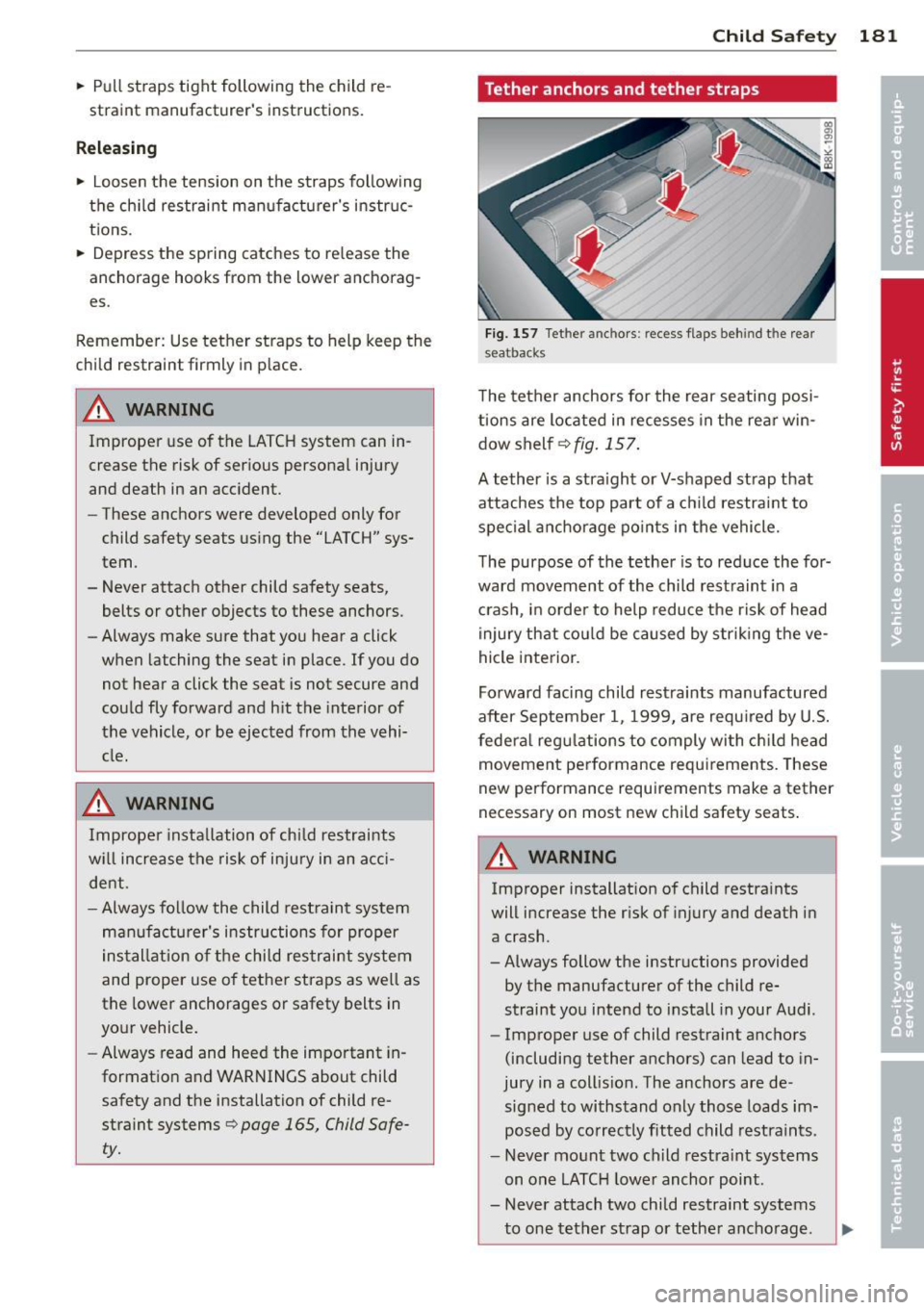
.. Pull straps tight following the child re
straint manufacturer's instructions.
Releasing
.. Loosen the tension on the straps following
the ch ild restraint manufacturer's instr uc
tions .
.. Depress the spring catches to re lease the
anchorage hooks from the lower anchorag
es.
Remember: Use tether straps to help keep the
child restraint firmly in p lace.
A WARNING
Improper use of the LATCH system can in
crease the risk of ser ious personal injury
and death in an acc ident.
- These anchors were developed only for
child safety seats us ing the "LATCH" sys
tem.
- Never attach other child safety seats,
belts or other objects to these anchors.
- Always make sure that you hear a click
when latching the seat in place. If you do
not hear a click the seat is not secure and
cou ld fly forward and h it the interior of
the vehicle, or be ejected from the vehi cle.
A WARNING
Imprope r installation of ch ild restrai nts
w ill increase the risk of injury in an acc i
de nt.
- Always fo llow the child rest raint system
m anufactu rer's ins tru ctions for proper
ins tallation of the child res traint system
and proper use of tether straps as we ll as
the lower anchorages or safety belts in
your vehicle.
- Always read and heed the important in
format ion and WARNINGS about child
safety and the installation of child re
straint systems
Q page 165, Child Safe
ty.
-
Child S afety 181
Tether anchors and tether straps
Fig. 157 Tet her anchors: recess flaps behind th e rear
seatbacks
T he te ther anchors for the rear seating posi
tions are located in recesses in the rear win
dow shelf¢
fig. 15 7.
A tether is a stra ight or V-s haped st rap that
attaches the top par t of a ch ild restrai nt to
spe cial a nchorage po ints in the vehicle.
T he purpose of the tether is to reduce the for
ward movement of the child rest raint in a
c rash, i n orde r to help reduce the risk of head
i njury that cou ld be caused by str ik ing the ve
hicle inte rior .
Fo rward facing child rest raints manufactured
after September 1, 1999, are requ ired by U.S.
federa l reg ulations to comply wi th ch ild head
movement pe rformance requ irements. These
new performance requirements make a tether
necessary on most new child safety seats .
A WARNING
Improper installat ion of child restra ints
will increase the r isk of injury and death in
a crash.
-Always follow the instr uctions provided
by the manufacturer of the child re
straint you intend to install in your Audi.
- Improper use of child restraint anchors
(including tether anchors) can lead to in
jury in a coll ision. The anchors are de
signed to withstand only those loads im
posed by co rrectly fitt ed child restraints.
- Neve r mo unt two child rest ra int systems
on one LATC H lower anchor point.
- Never attach two child restraint systems
-
to one tether strap o r tethe r ancho rage . ~
Page 184 of 294
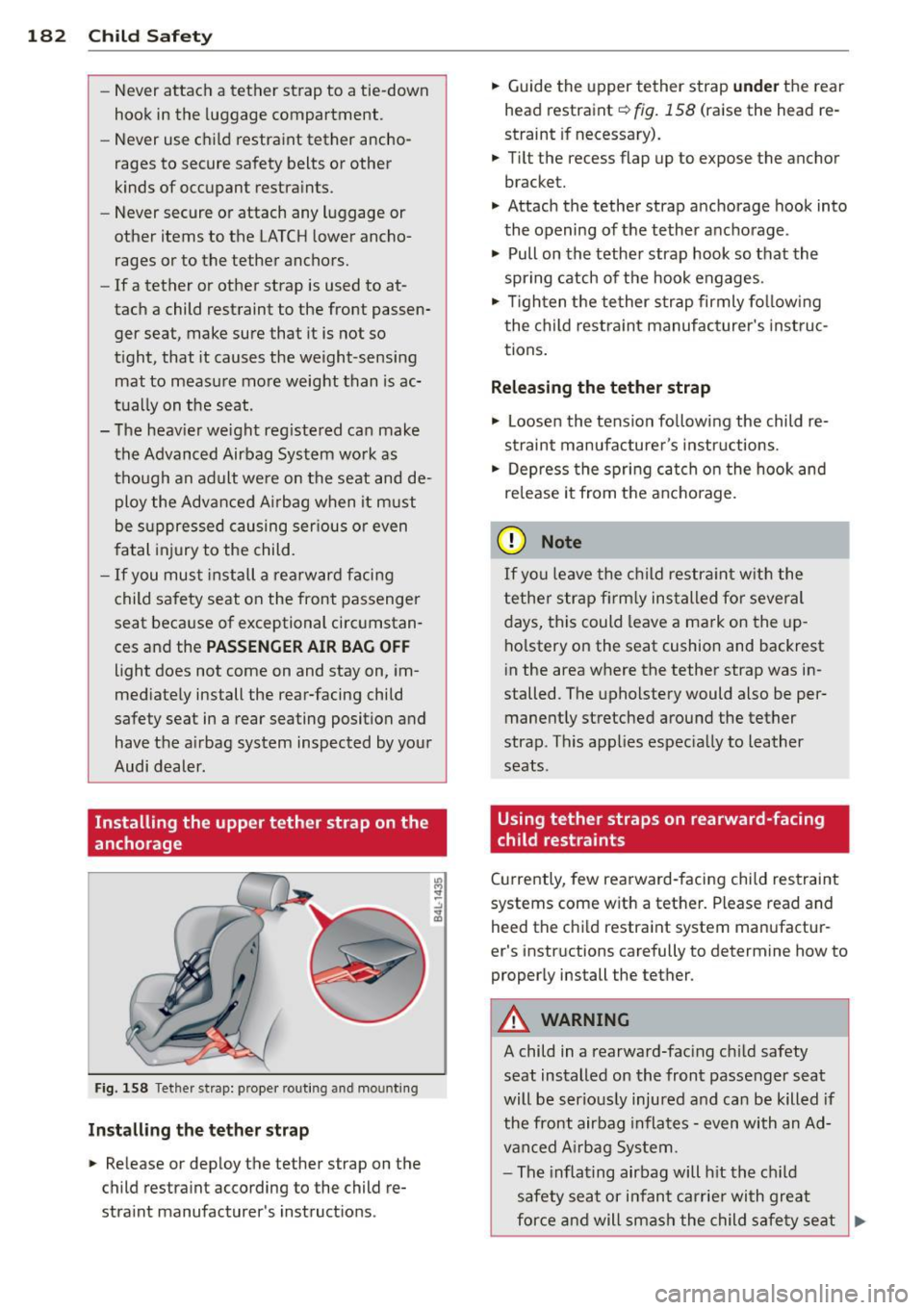
182 Child Safet y
-Never attac h a tether strap to a tie-down
hook in the luggage compartment .
- Never use c hild restraint tether ancho
rages to secure safety belts or other
kinds of occupant restra ints .
- Never secure or attach any l uggage or
other items to the LATCH lower ancho
rages or to the tether anchors.
- If a tether or other strap is used to at
tac h a child restraint to the front passen
ger seat, make sure that it is not so
t ight, that it causes the weight -sensing
mat to measu re more weight than is ac
tua lly on the seat.
- The heav ier weight reg istered can make
the Advanced Airbag System wo rk as
though an adult we re on the seat and de
ploy the Advanced A irbag when it m ust
be s uppressed causing ser ious or even
fatal inj ury to the child.
- If you mus t install a rearward f acing
child safety seat on the front passenger
seat because of exceptional circ umstan
ces and the
PASSENGER AIR BAG OFF
light does not come on and stay on, im
mediately install the rear-facing child
safety seat in a rear seating position a nd
have the a irbag system inspected by you r
Audi dealer.
Installing the upper tether strap on the
anchorage
F ig . 1 58 Tethe r strap: prope r rou ting and mounting
Installing the tether strap
.,. Release or deploy the tether strap on the
child restra int acco rding to the child re
straint manufacturer's instruct ions . .,.
Guide the upper tether strap
under the rear
head restraint co
fig. 158 (raise the head re
straint if necessary).
.,. Tilt the recess flap up to expose the anchor
bracket.
.,. Attach the tether strap anchorage hook into
the opening of t he tether anchorage.
.,. Pull on the tethe r strap hook so that the
spri ng catch of the hook engages .
.,. Tight en t he te ther s tra p firmly fo llow ing
the child restraint manufac turer's instruc
tions .
Releasing the tether strap
.,. Loosen the tens ion fo llowing the child re
s traint manufa cture r's instr uctions.
.,. Depress the spring c atc h o n the hook and
release it from the ancho rage.
(D Note
If yo u leave the child restr aint w ith the
tethe r strap firm ly ins talled for several
days, this could leave a ma rk on the up
ho lstery on the seat cushion and backrest
i n the area where the tether strap was in
stalled. The upholstery would also be per
manently stretched around the tether
strap . This applies espec ia lly to leather
seats .
Using tether straps on rearward-facing
child restraints
Currently, few rearward-facing child res traint
systems come w ith a tether. Please read and
heed the c hild restra int system man ufactur
er 's instr uctions carefully to determine how to
properly install the tether .
A WARNING
-
-
A child in a rearward-fac ing ch ild safety
seat installed on the front passeng er seat
will be s erious ly inju re d and ca n be killed if
the fr ont air bag infla tes -even with an Ad
va nced A irbag Sys tem .
- Th e inflating airbag will h it th e chi ld
safety sea t or infant c arrie r wi th gre at
for ce and will sma sh the child s afety seat
~
Page 185 of 294
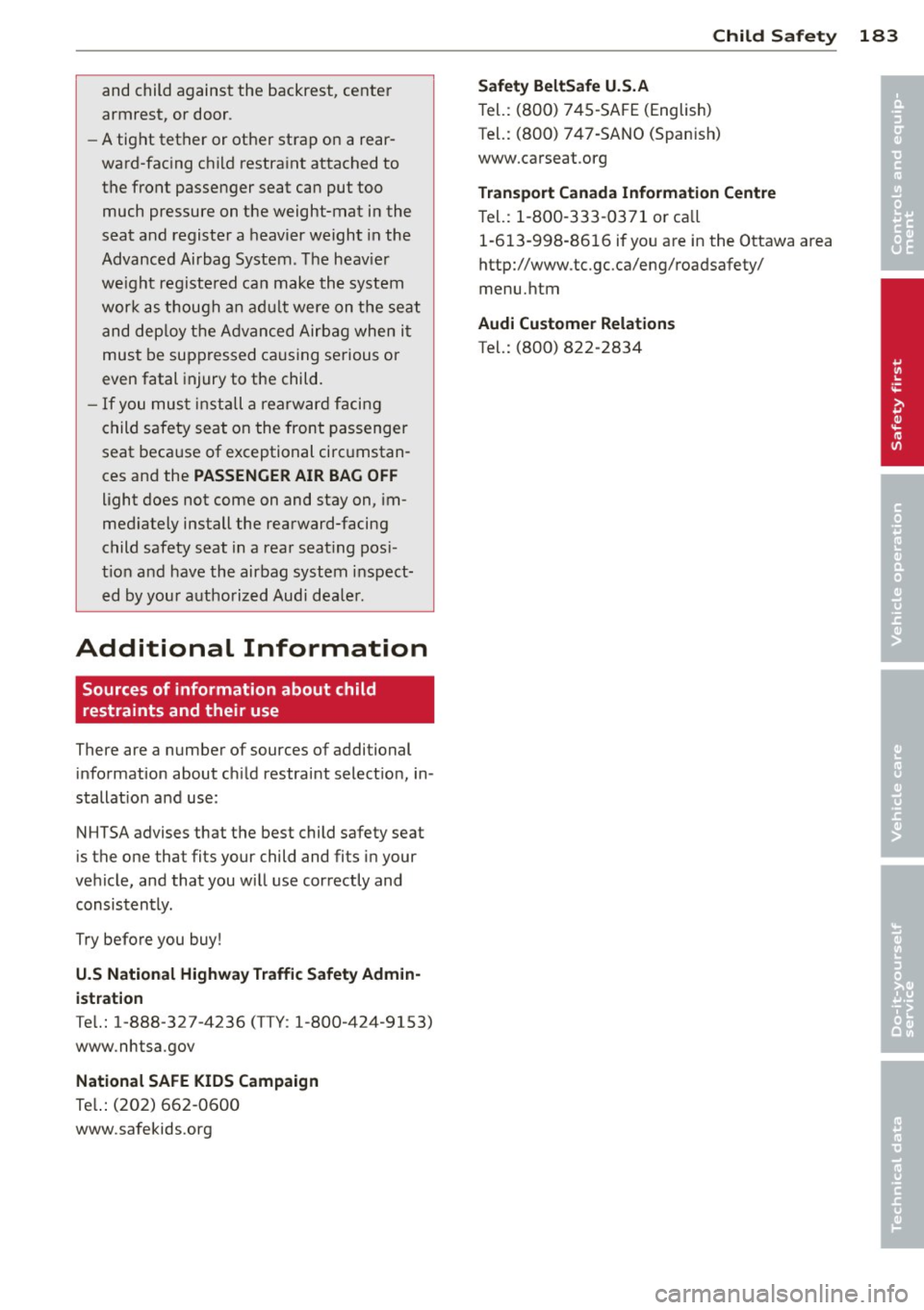
and child against the backrest, center
armrest, or door .
- A tight tether or other strap on a rear
ward-fac ing c hild restra int attached to
the front passenger seat can put too much pressure on the weight-mat in the
seat and register a heavier weight in the
Advanced Airbag System . T he heav ie r
we ight registe red ca n make th e system
wor k as thoug h an adu lt were on t he seat
and dep loy the A dvanced Airbag when i t
must be suppressed ca using serious or
even fatal injury to the child.
- If you mus t inst all a rearw ard facing
child safety seat on the front passenger
seat because of exceptional circ umstan
ces and the
PASSENGER AIR BAG OFF
light does not come on and stay on, im
med iate ly install the rearward-facing
child safety seat in a rear seat ing pos i
t io n and have the airbag system inspect
ed by you r a uthorized Audi dea le r.
Additional Information
Sources of information about child
restraints and their use
There are a number of sources of additional
information about ch ild restrai nt select ion, in
stallat ion and use:
NHTSA advises that t he best child safety seat
is the one that fits y our child and fits i n your
ve hicle, and that you w ill use correctly and
consis tently.
Try before you buy !
U.S National Highway T raffic Safety Admin
istration
T e l. : 1-888-327-4236 (T TY : 1-800-424-9153)
www.nhtsa.gov
National SAFE KIDS Campaign
Te l.: (202) 662 -0600
www.safekids.o rg
Child Sa fet y 183
Safety BeltSafe U.S.A
Tel.: (800) 7 45 -SAFE (English)
T el.: (800) 747-SANO (Span ish)
www.carseat.org
Transport Canada Information Centre
Tel.: 1 -800-333-0371 or ca ll
1 -6 13-998-86 16 if yo u are in the Ottawa a rea
http://www .tc.gc.ca/eng/roadsafety/
menu.htm
Audi Customer Relation s
Tel.: (800) 822-2834
•
•
Page 186 of 294
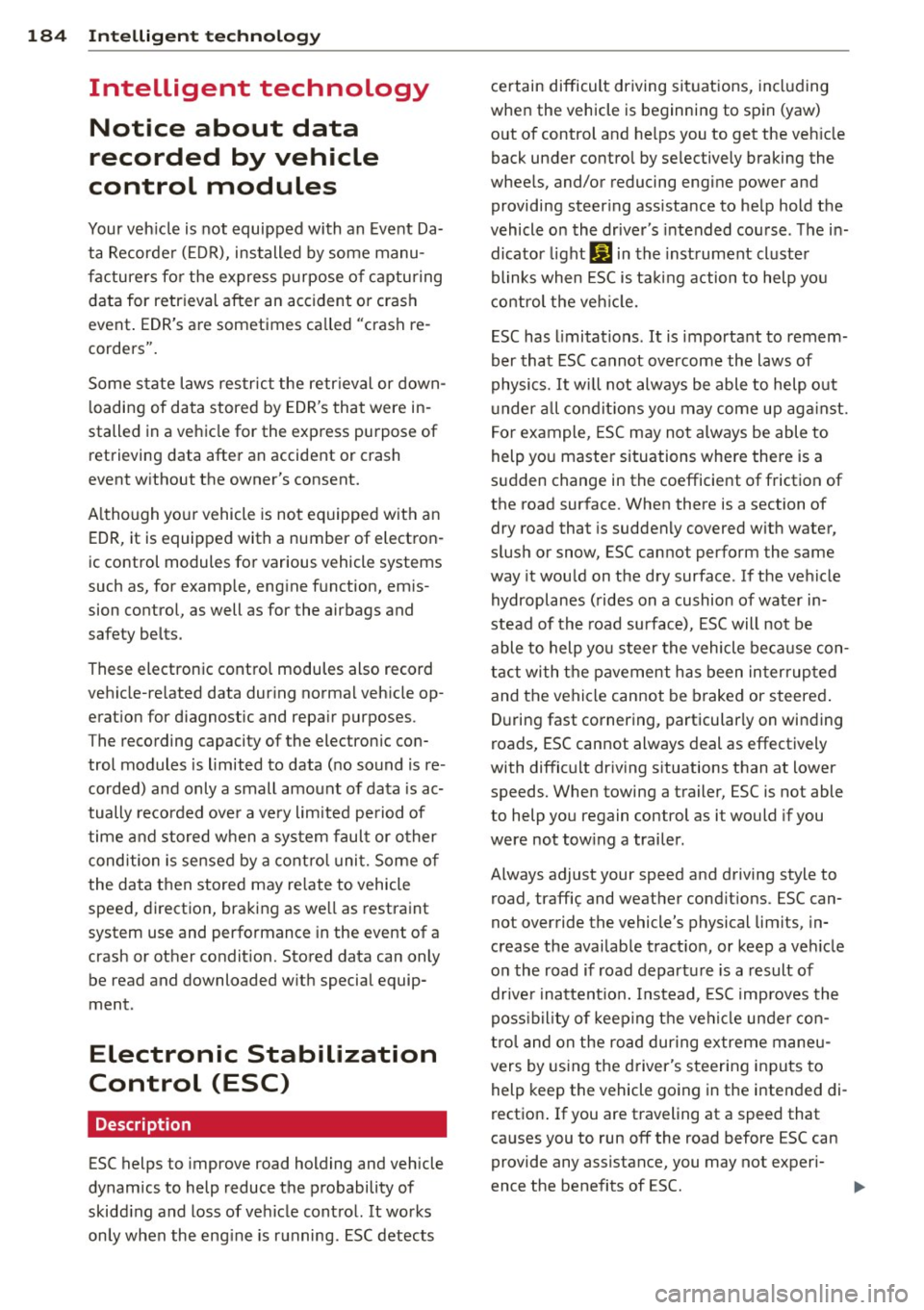
184 Intelligent technology
Intelligent technology
Notice about data
recorded by vehicle
control modules
Your veh icle is not equipped with an Event Da
ta Recorde r (EDR), ins talled by some manu
facture rs fo r the express p urpose of capturing
data for retrieval after an accident or cras h
event . EDR's are sometimes ca lled "crash re
corders".
Some state laws restr ict the retr ieval or down
loading of data stored by EDR's that were in
stalled in a vehicle for the express purpose of retrieving data after an accident or crash
event without the owner's consent.
A ltho ugh yo ur vehicle is not equ ipped wit h an
EDR, it is equipped with a number of electron
ic control modules for various vehicle systems
such as, for examp le, eng ine f unction, em is
sion control, as well as for the airbags and
safety belts.
These electronic contro l modules also record
vehicle-re lated data during norma l vehicle op
erat ion for diagnostic and repa ir purposes.
The recording capacity of the electronic con
trol modules is limited to data (no sound is re
corded) and only a small amount of data is ac
tually recorded ove r a ve ry limited pe riod of
time and stored when a sys tem faul t or o ther
cond ition is sensed by a cont ro l u nit. Some of
the data then stored may re late to vehicle
speed, direction, braking as we ll as restraint
system use and performance in the event of a
crash or other condit ion. Stored data can only
be read and downloaded w ith special equip
ment.
Electronic Stabilization
Control (ESC)
Description
ESC helps to improve road holding and vehicle
dynamics to help reduce the probability of
skidd ing and loss of ve hicle control. It works
only when the eng ine is running. ESC detects certain difficult driving situat
ions, including
when the vehicle is beginning to spin (yaw)
o ut of control and he lps you to get the veh icle
back under control by se lectively braking the
whee ls, and/or reducing eng ine power and
providing steer ing ass istance to he lp hold the
vehicle o n the dr iver's intended course. The in
dicator light
G) in the inst rument cluster
blinks when ESC is ta king action to help yo u
control the veh icle.
ESC has limitations.
It is importa nt to remem
ber that ESC cannot overcome the laws of
physics. It wi ll not always be able to help out
under a ll cond it ions you may come up aga inst.
F or example, ESC may not always be able to
help you master situations where there is a
s u dden change in the coefficient of friction of
the road surface. When there is a section of
dry road that is sudden ly covered w ith water,
s lush or snow, ESC cannot perform the same
way it wou ld on the dry surface . If the ve hicle
hydroplanes (rides on a cushion of water in
stead of the road surface), ESC will not be
able to help you steer the vehicle because con
tact with the pavement has been in terrupted
and the vehicle cannot be braked or steered .
D uring fast cornering, particularly on winding
roads, ESC cannot always deal as effectively
with difficult driving situations than at lower
speeds. When towing a trailer, ESC is not able
to help you regain control as it would if you
were not tow ing a trailer.
Always adjust your speed and driving style to road, traffic; and weather condit ions. ESC can
not override the vehicle's physical limits, in
crease the availab le tract ion, or keep a ve hicle
on the road if road departure is a result of
drive r inattent io n. Instead, ESC imp roves the
poss ibil ity of keeping the vehi cle under con
trol and on the road during ex treme maneu
vers by using the d river's steering inputs to
help keep the vehicle going in the intended di
rection . If you are traveling at a speed that
ca uses you to run off the road before ESC can
provide any assistance, you may not experi
ence the benefits of ESC.
Page 187 of 294
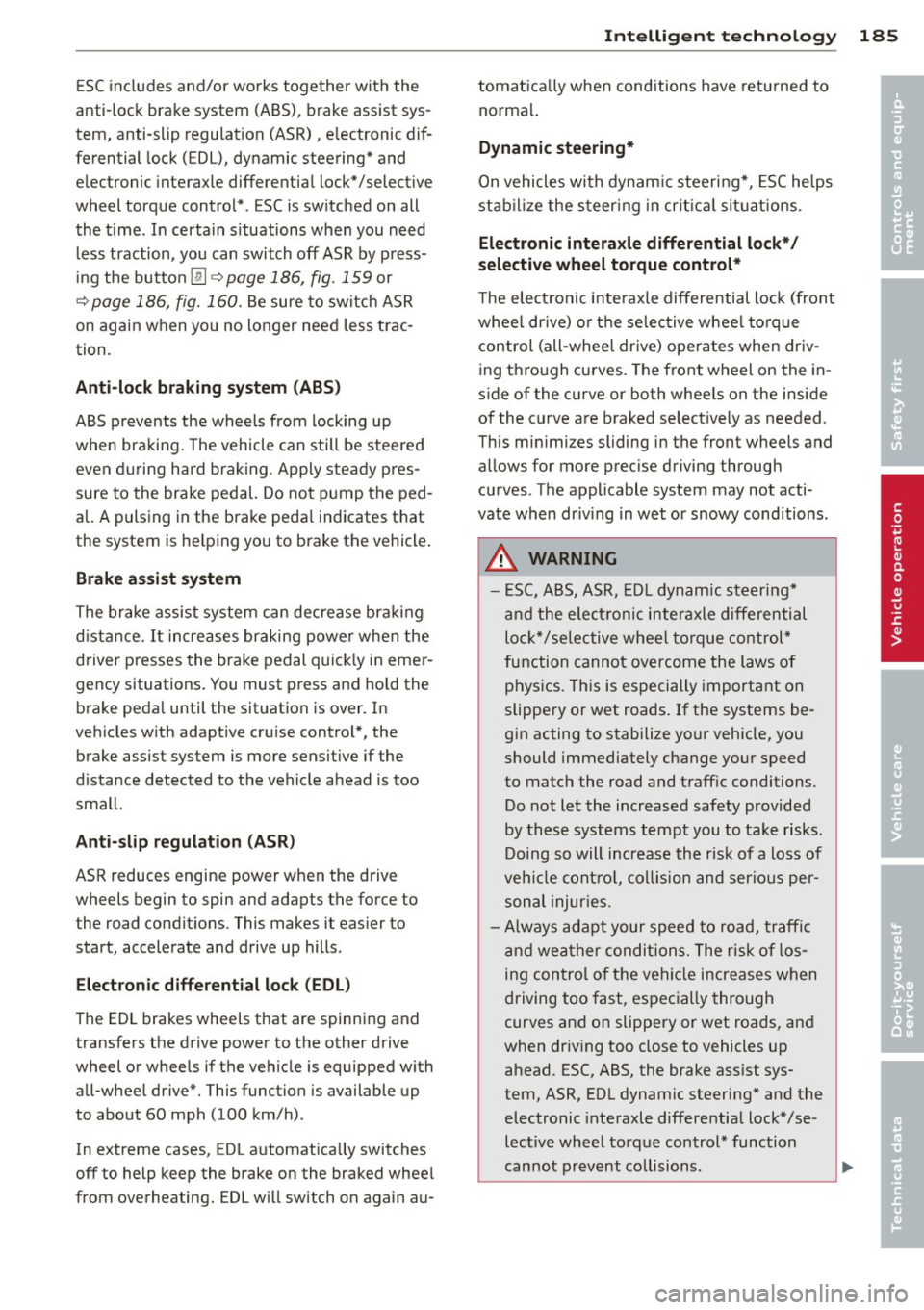
ESC includes and/or works together with the
anti-lock brake system (ABS), brake assist sys
tem, anti -slip regulation (ASR) , e lectronic dif
ferential lock (EDL), dynamic steering* and electronic i nteraxle differential lock* /selective
wheel torque control* . ESC is switched on all
the t ime. I n certain s ituations when you need
less traction, you can switch
off ASR by press
i ng the button~~
page 186, fig. 159 or
~ page 186, fig. 160. Be sure to sw itch ASR
on again when you no longer need less trac
tion.
Anti-lock b ra king s ystem (ABS)
ABS prevents the wheels from locking up
when braking. The vehicle can still be steered
even d uring hard brak ing . Apply ste ady p res
sure to the brake pedal. Do not pump the ped
a l. A pulsing in the brake peda l indicates t hat
the system is he lping you to brake the vehicle .
Brake assist system
The brake assist system can decrease bra king
d istance. It increases braking power when the
d river presses the brake pedal quick ly in eme r
gency situations . You must press and hold the
brake peda l until the situation is over. In
veh icles w ith adaptive cru ise contro l*, the
brake assist system is more sensit ive if the
d istance detected to the veh icle ahead is too
small.
Anti- slip regulati on (ASR)
ASR reduces engine power when the drive
wheels begin to spin and adapts the force to
the road condit ions. This makes it eas ier to
start, accelerate and drive up hills.
Elect ronic diffe renti al lo ck (EDL )
The ED L brakes wheels that are spinning and
transfers the drive power to the other drive
wheel or wheels if the vehicle is equipped with
all-wheel drive*. This function is available up
to about 60 mph (100 km/h) .
In extreme cases, EDL automatica lly switches
off to help keep the brake on the braked whee l
from overheating. EDL w ill switch on again au-
Intellig ent technolog y 185
tomat ica lly when conditions have returned to
norma l.
Dynamic steering*
On vehicles with dynam ic steering*, ESC helps
stab il ize the s teer ing in crit ica l sit uat io ns.
Electronic interaxle differential lock* /
selective wheel torque control*
T he electronic i nteraxle differential lock (front
whee l dr ive) or the se lective whee l to rque
control (all-whee l dr ive) opera tes when dr iv
ing thro ugh curves. The front wheel on the in
side of the c urve or both whee ls on the inside
of the curve are braked selectively as needed .
This min imizes sliding in the front wheels and
allows for more precise driving through
cu rves . The applicable system may not acti
vate when dr iv ing in wet or snowy conditions.
A WARNING
- ESC, ABS , ASR, EDL dynam ic steering*
a nd the elect ronic interaxle differential
loc k* /se lective wheel torque control*
function cannot overcome the laws of
physics. This is especially important on
slippery or wet roads . If the systems be
gin acting to stabilize your vehicle, you
should immediately change yo ur speed
to match the road and traff ic conditions.
Do not let the increased safety provided
by these systems tempt you to take risks .
Doing so will increase the risk of a loss of
veh icle contro l, col lision and ser ious per
sonal injuries.
- Always adapt your speed to road, traffi c
and wea ther conditions. The risk of los
ing con tro l of the vehicle increases when
driving too fast, espec ially through
curves and on slippery or wet roads, and
when dr iv ing too close to vehicles up
ahead. ESC, ABS, the brake ass ist sys
tem, ASR, EDL dynam ic steering* and the
electronic interaxle differentia l lock*/se
lective whee l torque control* function
cannot prevent collisions.
•
•
Page 188 of 294
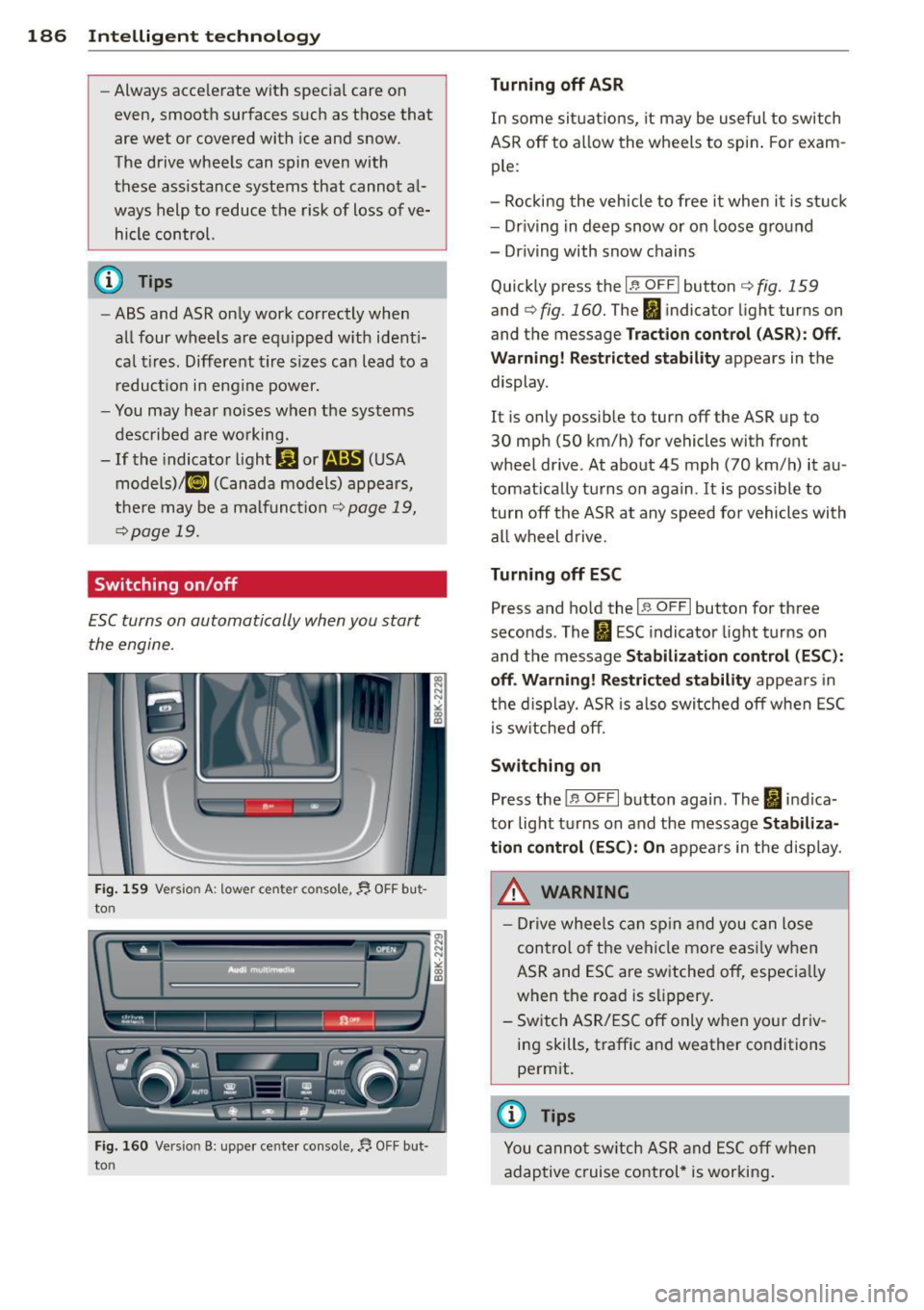
186 Intelligent technology
-Always accelerate with special care on
even, smooth surfaces such as those that
are wet or covered with ice and snow.
The drive wheels can spin even with
these assistance systems that cannot al
ways help to reduce the risk of loss of ve hicle control.
(i_) Tips
- ABS and ASR only work correctly when
all four wheels are equipped with identi
cal tires . Different tire sizes can lead to a
reduction in engine power.
- You may hear noises when the systems
described are working .
- If the indicator light
I] or l;S (USA
models);tl] (Canada models) appears,
there may be a malfunction ¢
page 19,
¢page 19.
Switching on /off
ESC turns on automatically when you start
the engine .
Fig. 159 Vers ion A: low er ce nter c onsol e, 1', OFF but
to n
.... .. [ I _j nw· 1-_, .. _ , 1 -- - .-=---1
I;· . i-a~ -~ ~-,' I ' .;- c;.il..-~ -~ 1,1
~' . -' '
1 ' ...... ~ ... ~- ;. '"~ l __,
Fig. 160 Versio n B: upper ce nter console,!'> OFF but
to n
Turning off ASR
In some situations, it may be useful to switch
ASR
off to allow the wheels to spin. For exam
ple:
- Rocking the vehicle to free it when it is stuck
- Driving in deep snow or on loose ground
- Driving with snow chains
Qu ickly press the
i.i, OFF I button ¢ fig. 159
and¢ fig. 160. The fi indicator light turns on
and the message
Traction control (ASR): Off.
Warning! Restricted stability
appears in the
display .
It is only possible to turn off the ASR up to
30 mph (SO km/h) for vehicles with front
wheel drive . At about 45 mph (70 km/h) it au
tomatically turns on again .
It is possible to
turn
off the ASR at any speed for vehicles with
all wheel drive.
Turning off ESC
Press and hold the I B OFFI button for three
seconds . The
Ii ESC indicator light turns on
and the message
Stabilization control (ESC):
off. Warning! Restricted stability
appears in
the display. ASR is also switched
off when ESC
is switched off.
Switching on
Press the 1 .$ OFFI button again. The 11 indica
tor light turns on and the message
Stabiliza
tion control (ESC): On
appears in the display .
_&. WARNING
- Drive wheels can spin and you can lose
control of the vehicle more easily when
ASR and ESC are switched off, especially
when the road is slippery .
- Switch ASR/ESC
off only when your driv
ing skills, traffic and weather conditions
permit.
(D Tips
You cannot switch ASR and ESC
off when
adaptive cruise control* is working.
-
Page 189 of 294
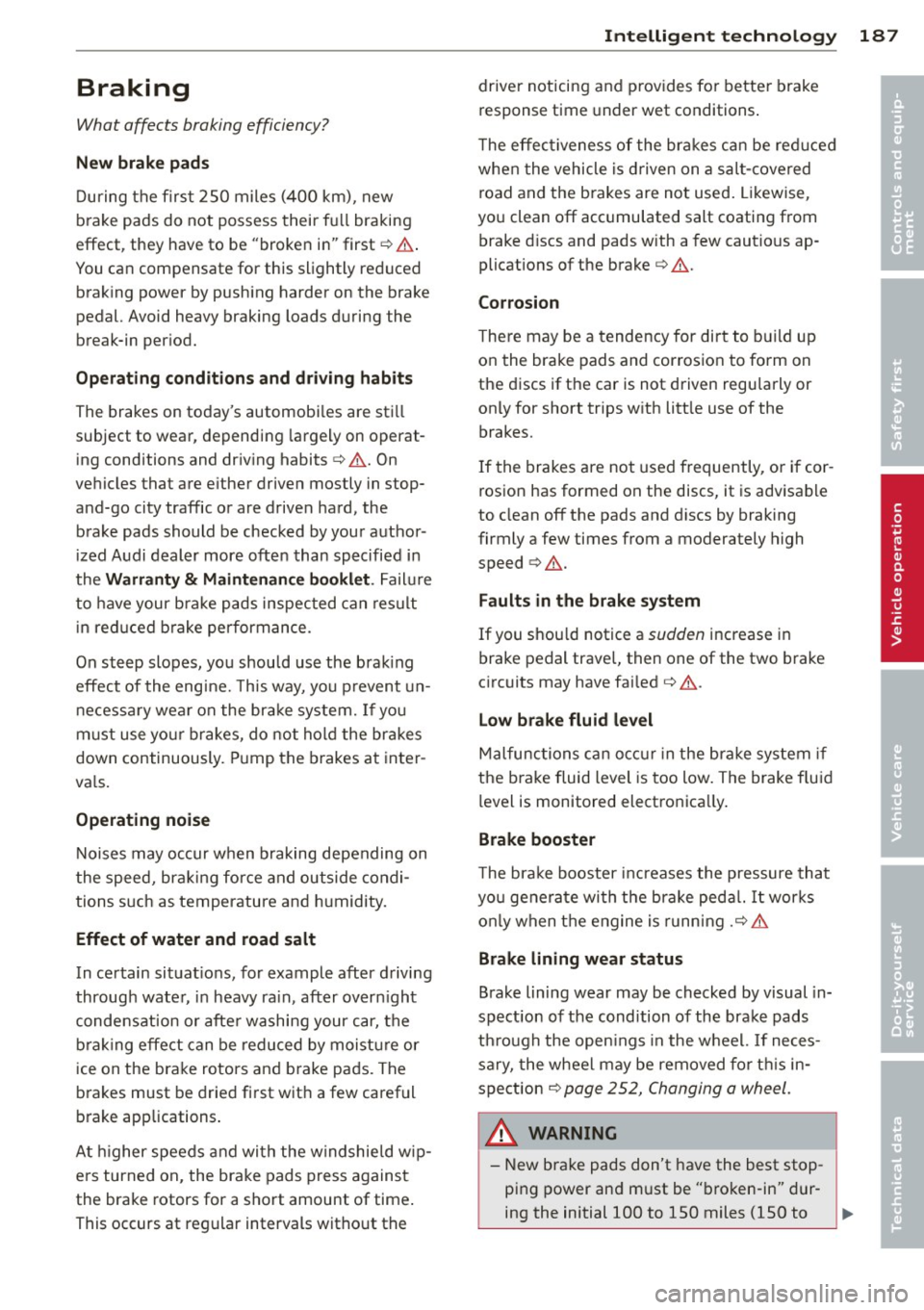
Braking
What affects braking efficiency?
New brake pads
During the first 250 miles (400 km), new
brake pads do not possess their full braking
effect, they have to be "broken in" first¢& .
You can compensate for this slightly reduced braking power by pushing harder on the brake
pedal. Avoid heavy braking loads during the
break-in per iod.
Operating conditions and driv ing habits
The brakes on today's automobi les are sti ll
subject to wear, depending largely on operat
ing conditions and driving habits¢.&. . On
vehicles that are e ither driven mostly in stop
and-go city traffic or are driven hard, the
brake pads should be checked by your author
ized Audi dealer more often than specified in
the
Warranty & Maintenance booklet . Failure
to have your b rake pads inspected can result
in red uced brake performance.
On steep slopes, you shou ld use the brak ing
effect of the engine. This way, you p revent un
necessary wear on the brake system.
If you
must use yo ur brakes, do not hold the brakes
down continuously. Pump the brakes at inter
va ls.
Operating noise
Noises may occur when braking depending on
the speed, braking force and outside condi
tions such as temperature and humidity.
Effect of water and road salt
In certain situat ions, for example after driving
through water, in heavy ra in, after overnight
condensation or after washing your car, the
braking effect can be reduced by moisture or
ice on the brake roto rs and brake pads . The
brakes must be dried first with a few careful
brake applications .
A t hi gher speeds and with the windshield w ip
ers turned on, the brake pads press against
the brake rotors for a short amount of time .
This occurs at regular intervals without the
Intelligent technology 187
driver noticing and provides for better brake
response time under wet conditions .
T he effectiveness of the brakes can be red uced
when the vehicle is driven on a sa lt-co vered
road and the b rakes are not used. Likewise,
you clean off accumulated salt coating from
brake discs and pads with a few cautious ap
plications of the brake ¢ & .
Corrosion
There may be a tendency for dirt to build up
on the brake pads and corrosion to form on
the discs if the car is not driven regu larly or
on ly for short trips with litt le use of the
brakes.
If the brakes are not used frequently, or if cor
rosion has formed on the discs, it is advisable
to clean off the pads and discs by braking
firmly a few times from a moderately high
speed ¢.&. .
Faults in the brake system
If you should notice a sudden increase in
brake pedal trave l, then one of the two brake
c ircuits may have failed ¢.&. .
Low brake fluid level
Malfunctions can occur in the brake system if
the brake fluid level is too low. The brake fluid
level is monitored electronica lly.
Brake booster
T he brake booster increases the pressure that
you generate with the brake peda l. It works
only when the engine is runn ing .¢ .&.
Brake lining wear status
Brake lining wear may be checked by visual in
spection of the condition of the brake pads
through the openings in the wheel. If neces
sary, the wheel may be removed fo r this in
spection ¢
page 252, Changing a wheel .
A WARNING
-
- New brake pads don't have the best stop
ping power and must be "broken-in" dur-
ing the initial 100 to 150 miles (150 to
~
•
•
Page 190 of 294

188 Intelligent technology
200 kilometers) of normal city driving.
You can compensate for this by pressing
the brake pedal more firmly. This also applies later when new pads are instal
led .
- You should perform braking maneuvers
for the purpose of cleaning the brake
system only if road conditions permit.
Other road users must not be put at risk -
you may cause an acc ident!
- Before descending a steep grade, reduce
speed and shift transmission into a lower
gear or lowe r driving range. Do not ride
the brakes or hold the pedal down too
long or too often. This could cause the
brakes to get hot and diminish braking
efficiency.
- Do not "ride the brakes" by resting your
foot on the pedal when you do not intend
to brake . This may cause the brakes to
overheat, premature wear and increased
stopping distance.
- Under certain climatic and operating
conditions such as passing through wa
ter, driving in heavy rain or after washing
the vehicle, the effectiveness of the
brakes can be reduced. In winter, ice can
accumulate on the brake pads, linings,
discs and drums. Carefully apply brakes
for a test. Brakes will dry and ice coat
ings will be cleaned off after a few care
ful brake applications.
- Driving for an extended period of time on
salt-covered roads without using your
brakes can also affect braking efficiency.
Clean off accumulated salt coating from
brake discs and pads with a few careful
brake applications.
- If you damage the front spoiler, or if you
install a different spoiler, be sure the air
flow to the front brakes is not obstruct
ed . Otherwise the brake system could
overheat reducing the effectiveness of
the entire brake system.
- Failure of one brake c ircuit will impair
the braking capability resulting in an in
creased stopping distance. Avoid driv ing
the vehicle and have it towed to the near- est authorized Audi dealer or
qualified
workshop.
- Never let the vehicle roll to a stop with
the engine shut off.
- If the brake booster is not working, for
example when towing your vehicle, or
because the brake booster has somehow
been damaged, the brake pedal must be
pressed considerably harder to make up
for the lack of booster assistance.
Electro-mechanical
power assist, dynamic
steering
The electro-mechanical power assist helps
the driver when steering.
Power steering adapts electronically based on
the vehicle speed .
Indicator lights and messages
• Steering defective! Do not drive vehicle!
If this indicator light turns on and stays on
and this message appears, the power steering
may have failed.
Do
not continue driving . See your authorized
Audi dealer or other qualified repair facility
for assistance.
E!"4 Dynamic steering: System fault! You can
continue driving
If the indicator light turns on and the mes
sage appears, the steering may be more diffi
cult to move or more sensitive than usual. The
steering wheel may also be at an angle when
driving straight .
Drive slowly to your authorized Audi dealer or
qualified workshop to have the malfunction
corrected .
ls!'fl Dynamic steering: initializing
If this driver message appears and the indica
tor light is flashing on the instrument panel,
dynamic steering* is being reinitialized. Once
you start the engine after this is finished, the ..,..